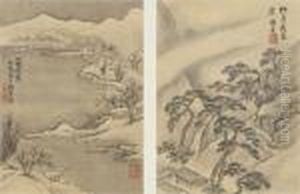Yang Jin Paintings
Yang Jin was a Chinese painter during the Qing Dynasty, born in 1644 and passing away in 1728. His life spanned a period of significant transition in China, witnessing the establishment and consolidation of Qing rule. Yang Jin was primarily known for his landscapes and flower-and-bird paintings, a genre that holds a prestigious place in Chinese art history.
Yang Jin's style was deeply rooted in the traditions of Chinese painting, yet he managed to infuse his work with a sense of freshness and vitality that was characteristic of his personal vision. His landscapes often depict serene and harmonious scenes that are imbued with a profound sense of spiritual tranquility, reflecting the artist's own search for peace and balance in a time of change.
Despite the upheavals of his era, Yang Jin dedicated himself to the pursuit of artistic excellence. He was deeply influenced by earlier masters, yet he was not afraid to experiment within the conventions of Chinese painting. His works are noted for their meticulous detail, vibrant life, and the subtle use of color.
Yang Jin's contribution to Chinese art was not merely in the beauty of his paintings but also in his role as a bridge between the Ming and Qing dynasties' artistic traditions. Through his art, he preserved the essence of Chinese cultural heritage, while also paving the way for future generations of artists. His legacy is preserved in various collections, both in China and internationally, where his works continue to be studied and admired for their elegance, depth, and historical significance.













